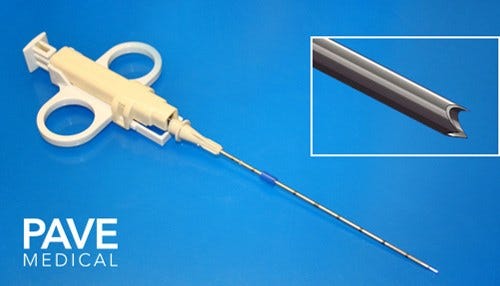Pave Preps First-of-its-Kind Lung Biopsy Device
 Pave says its full core biopsy device gives clinicians a smaller needle than ever before to collect lung biopsies.
Pave says its full core biopsy device gives clinicians a smaller needle than ever before to collect lung biopsies.
Subscriber Benefit
As a subscriber you can listen to articles at work, in the car, or while you work out. Subscribe NowLung cancer is the leading cause of cancer death, and doctors are clamoring for a better way to diagnose it. A Zionsville-based startup is creating a lung biopsy device that it says gives clinicians something they’ve never had before: a smaller needle and a safer tissue-collection process that produces a clearer diagnosis for the patient. Pave LLC leaders say it meets a critical need as personalized medicine transforms cancer treatment, because the advances demand a better biopsy.
“If you’re a patient, one of the things you really don’t want to hear is, ‘You went through this biopsy, you went through all this pain, and the tissue we received from this biopsy was non-diagnostic,’” says Pave President Doug Knoll. “In other words, you’re going to have to do this biopsy again.”
Pave believes it can reduce this scenario by giving doctors a better biopsy tool that collects more tissue in a single procedure. A lung biopsy involves removing samples of lung tissue with a special needle to determine if cancer or lung disease are present. Pave Chief Executive Officer Debb Beck says lung biopsies are especially difficult, because they carry unique challenges.
“Anytime you’re poking a hole in the lung, you have increased risk to the patient,” says Beck.
“Pneumothorax (collapsed lung) can occur, when air gets in between the lung and chest wall,” says Knoll. “It’s a very serious condition that can be dangerous, painful and may require medical intervention. The smaller the needle, the less risk of something like that happening.”
And that’s why Pave is aiming to give clinicians a smaller needle than ever before to collect lung biopsies: 20 gauge. But the full core biopsy device has another critical feature that Pave says differentiates it from conventional ones: a cone.
“Envision a tube…the furthest part of the tube has a very thin, sharp edge, and the cone extends into the interior of the tube until it hits the inner diameter,” says Knoll. “When that’s fired forward into tissue, the tissue is then compressed into the cannula (thin tube) and retained when removing the device.”
Pave says the innovative cone design enables the device to collect a larger amount of tissue, which opens the door to pinpointing personalized cancer treatments based on the genetics of the individual’s disease. A 2015 personalized cancer medicine trial led by the National Cancer Institute revealed that one in five samples—obtained using standard biopsy methods—didn’t have enough cancerous cells to analyze, and therefore, the patients couldn’t be matched with personalized treatments.
Pave leaders believe the device solves a major market need for lung biopsies: the collection of a large sample in a smaller-than-ever package size.
“The more tissue that you can get from a patient, the more biomarkers that are available within it; you’re able to do more testing on it and target your treatment plan accordingly,” says Knoll. “So, the ideal would be to have a needle that has the maximum amount of tissue collection capability for its size.”
Beck says Pave has also simplified the design of the full core biopsy device, describing it as lightweight and balanced. These factors are important during a CT scan when the doctor needs to walk away and leave the device in place to check the placement before firing.
Pave got its start in 2015 as a spinoff from Promex Technologies, where three of the startup’s five founders held leadership positions; Texas-based Argon Medical Devices acquired Promex. Pave is currently testing prototypes, refining the device and working with Indianapolis-based venture development organization Elevate Ventures to prepare for fundraising.
“Making a device for full core biopsy is technically challenging to begin with,” says Beck, “and to make it in an even smaller size is even more challenging.”
“We have a solution that allows the device to be simple to manufacture, cheap to manufacture and allows it to be extremely effective for the job; that’s our biggest strength,” says Knoll. “We’re pushing hard, because this is a wide-open opportunity.”
Knoll says Pave’s device collects the larger samples pathologists need, while maintaining a small profile.
Beck says the device has characteristics that make it ideal for lung biopsies and other respiratory diseases that require biopsy.

